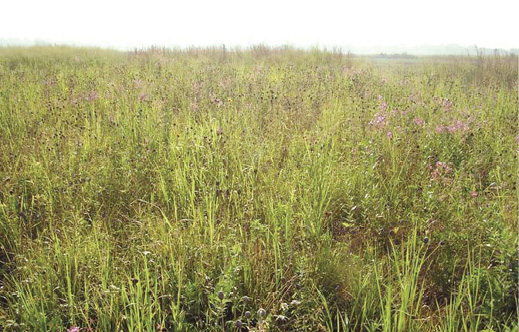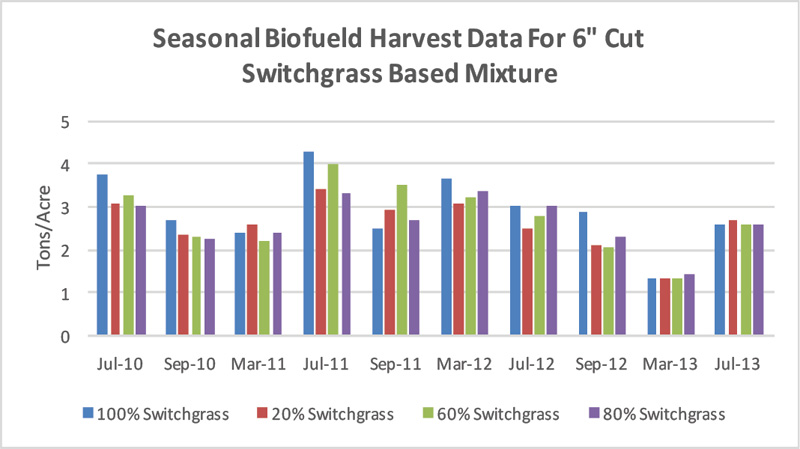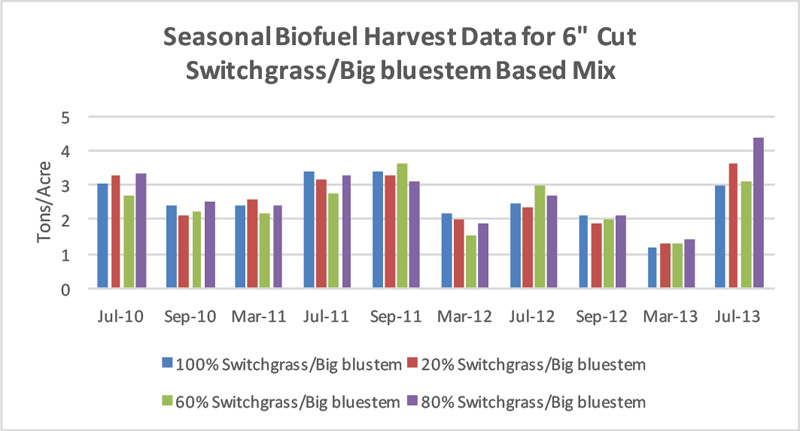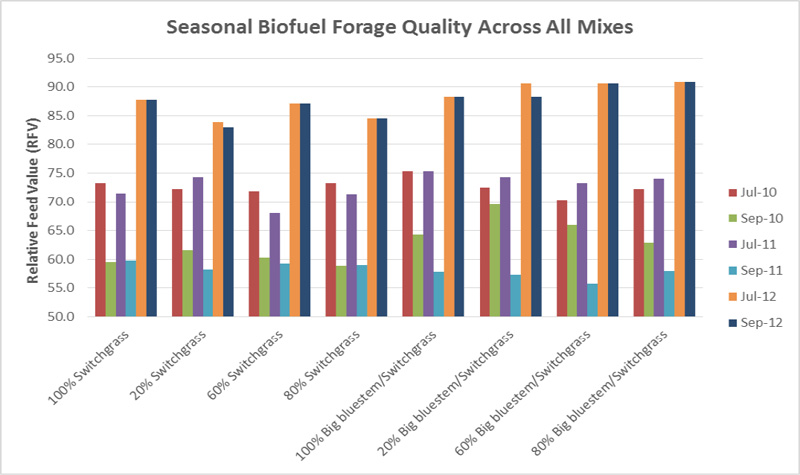Multi-year demonstrations were established at the University of Missouri Bradford Research Center near Columbia, Mo., to determine the benefits of establishing native grasses, forbs and legumes as an alternative crop for producing economical biomass and quality forage for livestock and for enhancing wildlife habitats. Having crop production systems suited to multiple uses is crucial to success in evolving markets and to satisfying increasing demand for Missouri agricultural products. One of the main objectives of the case study was to determine whether these mixtures could produce, or yield, as much biomass and livestock forage as monoculture, or single species, stands of native grasses in Missouri, as well as to evaluate these mixtures' comparative quality.
This guide is a companion to MU Extension publications G9422, Integrating Practices That Benefit Wildlife With Crops Grown for Biomass in Missouri, and G9423, Mixtures of Native Warm-Season Grasses, Forbs and Legumes for Biomass, Forage and Wildlife Habitat, which outlines the benefits of using these mixtures of native warm-season forages and provides information to help landowners make informed decisions on enhancing wildlife habitats while producing crops for biomass. Establishment and management practices, as well as yield results, are presented as a case study in this guide so that others can implement similar practices on their property.
Research conducted at the University of Minnesota revealed that mixed stands of native warm-season grasses, forbs and legumes can produce biomass and, thus, potential greater forage yields at levels equal to or greater than monocultures of native grasses. Mixed stands have been referred to as low-input, high-diversity (LIHD) systems. Monocultures of grasses, which have higher soil fertility requirements, have been referred to as high-input, low-diversity (HILD) systems. LIHD systems use legumes as a source of nitrogen, whereas HILD systems tend to rely on commercial nitrogen fertilizers to produce biomass yields.

Demonstration using native warm-season forage mixtures, MU Bradford Research Center near Columbia, Mo. (Photo credit: Ray Wright)
To study the benefits of using native warm-season forage mixtures in Missouri, researchers established demonstrations at the MU Bradford Research Center near Columbia, Mo. These demonstrations were established to evaluate the potential for different mixes of native grasses, legumes and forbs (LIHD systems) to provide economical biomass production, provide quality forage for livestock and enhance habitats for wildlife and pollinators (Figure 1). They were compared against a monoculture of switchgrass and a mix of switchgrass and big bluestem (HILD system).
Native warm-season grasses tend to be high in fiber and low in protein compared with forbs and legumes. Mixing forbs and legumes with these grasses, such as in an LIHD system, can improve forage quality for livestock and food value for wildlife. However, it can be challenging to fine-tune the ideal ratio of native warm-season grasses, forbs and legumes to meet the needs of biomass production, livestock and wildlife.
Plant mixtures and establishment strategies
Stands of native warm-season grasses, including switchgrass and a mixture of switchgrass and big bluestem — each with species of native forbs and legumes — were established in a prepared seedbed at the MU Bradford Research Center in 2008. Clay pan soils predominate at this site. Soybeans had been planted the previous year in the field.
Table 1
Legumes and forbs used in plant mixtures.
| Legume | Scientific name |
|---|---|
| Patridge pea | Chamaecrista fasciculata |
| Illinois bundle flower | Desmanthus illinoensis |
| Showy tick trefoil | Desmodium candense |
| Roundhead lespedeza | Lespedeza capitata |
| Slender lespedeza | Lespedeza virginica |
| Sensitive briar | Mimosa quadrivalvis var. nuttallii |
| Forb | Scientific name |
| Ashy sunflower | Helianthus mollis |
| Wild bergamot | Monarda fistulosa |
| Purple coneflower | Echinacea purpurea |
| Plains coreopsis | Coreopsis palmate |
| Maximillian sunflower | Helianthus maximiliani |
| Oxeye false sunflower | Heliopsis helianthoides |
Legume species were selected based on their potential nitrogen fixing properties and production of seeds that were beneficial for wildlife. Forb species were selected based on their potential for producing adequate biomass and their capacity for providing wildlife benefits as determined by direct observation or from information obtained from the NRCS (Table 1) and from MU Extension publication MP903, Quail-Friendly Plants of the Midwest. Other criteria included cost, availability and a species' ability to compete with other plants in the stand.
Seeding ratios used for establishing the plots were 100-to-0, 80-to-20, 60-to-40 and 20-to-80 of native warm-season grass to forbs and legumes. Each was established using pure live seed (PLS) in a prepared seedbed at a rate of 50 seeds per square foot. This seeding rate reflects the recommended seeding rate on a per-acre basis for native warm-season grasses of 7 pounds PLS per acre and forbs at 3 pounds PLS per acre. Forbs and legumes were planted during the winter dormant season in January and February by broadcast seeding to allow freezing and thawing to work seed into the soil to the correct depth. Native warm-season grasses were established during this same period.
A soil test had been conducted and fertility amendments applied based on recommendations. The monoculture stand of switchgrass and switchgrass/big bluestem plots was fertilized with 80 pounds of nitrogen per acre according to soil test recommendations in the spring during each year of the study, which reflected an HILD system. The switchgrass variety used was Cave-in-Rock. Broadleaf weeds were controlled within the native warms season grass plots with the herbicide 2-4-D at full label rate.
Harvesting techniques
The plots were harvested during each spring, summer and fall season from 2010 to 2013. This harvest regime was intended to represent products (biomass) for biofuel in spring, livestock forage in summer and a combination of either use in fall.
Biomass was harvested with a forage harvester. Each demonstration plot — composed of the native warm-season grasses and the grass-and-forb mixtures was harvested once a year in summer, fall or spring at either a 6-inch or 12-inch cutting height to evaluate forage and biomass yield potential, forage quality and effects on wildlife habitat. Table 2 depicts average biomass yields for each of the mixtures by season of harvest.
Biomass yield and forage quality
Researchers measured biomass yields in dry tonnage and collected samples from each planting to be dried for forage analysis and moisture content measurement. This information was collected for the monoculture plantings, as well as for each of the grass, forb and legume mixtures. Results are summarized in the following sections.
Biomass yield
Table 2 shows the average biomass yield for the switchgrass and switchgrass/big bluestem mixtures, with the percentages of the forb and legume species used for each planting that was harvested during spring, summer and fall from 2010 until 2013. Researchers used this seasonal harvest timing and these cutting heights to compare each stand's capacity for biomass production and forage yield. Note that the mixtures with varying ratios of forbs and legumes had comparable yields to the monocultures of native warm-season grasses, particularly at the 6 inch harvest height, when harvested during each season. Figures 2 and 3 depict yield results for each year by season of harvest for the 6-inch harvest height. Harvesting at this height resulted in the greatest yield for each treatment during each season with the exception of harvests during 2013, when yields were comparable at both the 6- and 12-inch cutting height.
The moisture content percentage was factored into the overall weights to determine a dry tonnage yield weight for each plot. A typical hay harvest has a moisture level of 18 to 20 percent, but these weights include a 5 percent moisture measurement. Researchers determined biomass potential from estimates of cellulose, hemicelluloses and lignin provided by each of the plant mixtures that were established.
Table 2
Average biomass yields (in tons per acre) from summer 2010 through summer 2013 harvests.
| Mixture | Spring | Summer | Fall | |||
|---|---|---|---|---|---|---|
| 100% monoculture switchgrass | 2.4 | 2.0 | 3.4 | 2.1 | 2.5 | 2.2 |
| 80% switchgrass, 20% forb and legume | 2.4 | 1.8 | 2.9 | 2.2 | 2.5 | 1.9 |
| 60% switchgrass, 40% forb and legume | 2.2 | 2.1 | 3.2 | 1.9 | 2.4 | 1.7 |
| 20% switchgrass, 80% forb and legume | 2.3 | 1.8 | 3.4 | 2.2 | 2.4 | 1.9 |
| Cutting height | 6" | 12" | 6" | 12" | 6" | 12" |
| Mixture | Spring | Summer | Fall | |||
|---|---|---|---|---|---|---|
| 50% switchgrass, 50% big bluestem | 1.8 | 1.7 | 3.2 | 2.0 | 2.7 | 1.8 |
| 80% switchgrass and big bluestem, 20% forb and legume | 1.6 | 1.4 | 2.9 | 1.9 | 2.5 | 1.5 |
| 60% switchgrass and big bluestem, 40% forb and legume | 1.8 | 1.4 | 3.2 | 1.8 | 2.8 | 1.7 |
| 20% switchgrass and big bluestem, 80% forb and legume | 2.0 | 1.4 | 3.2 | 1.8 | 2.7 | 1.7 |
| Cutting height | 6" | 12" | 6" | 12" | 6" | 12" |
A comparison of yields between the switchgrass-monoculture and the combination of big bluestem-and-switchgrass with various mixtures of forb and legume species. The timing of harvest and the stubble height at cutting were used to determine the mixtures' biomass and forage production capacity. These biomass yields represent a three-year average for spring, summer and fall and were harvested at 6- and 12-inch stubble heights.

Biomass yield, in tons per acre, resulting from harvests conducted at the 6-inch cutting height, comparing monocultures of switchgrass with various combinations of switchgrass and legume-forb mixtures. Harvests were conducted during summer, fall and spring of 2010, 2011, 2012 and 2013. The 100% switchgrass monoculture represents a HILD system; LIHD systems are represented by plantings with varying ratios of forbs and legumes in the mixture.

Biomass yield, in tons per acre, resulting from harvests conducted at the 6-inch cutting height, comparing mixtures of switchgrass and big bluestem with various combinations of these native warm-season grasses with mixtures of forbs and legumes. Harvests were conducted during summer, fall and spring of 2010, 2011, 2012 and 2013. The 100% big bluestem and switchgrass planting represents a HILD system; LIHD systems are represented by plantings with varying ratios of forbs and legumes in the mixture.
Forage quality
A forage quality analysis was conducted on samples collected during summer and fall (Figure 4). A relative feed value (RFV) — which takes into consideration several measures of forage quality that are important for livestock producers — was used to compare forage quality between treatments. RFV is an index that ranks hay based on a calculation of digestible dry matter and dry matter intake. Acid and neutral detergent fiber values are the basis for this calculation. For example, mature alfalfa hay might have an RFV of 100, and most grass hays fall below an RFV of 100. Legumes and legume-grass mixes, on the other hand, have an RFV in excess of 100. RFV does not take protein level into consideration. An RFV below 80 will generally fall short of the energy requirements of most livestock.
In 2012, severe drought greatly affected yield and forage quality in a large percentage of Missouri pastures. The drought of 2012 caused a 25 percent yield loss as compared with the same harvest in 2011. Even in drought conditions, the tonnage and RFV of native warm-season grass and forb mixtures was greatest in 2012.

Forage quality relative feed values (RFV) for biofuel mixes. An RFV was determined for each native warm-season grass and forb mixture from summer and fall harvests from 2010 to 2012.
Summary
During this case study, mid-Missouri experienced levels of annual precipitation that were well below the long-term average, which influenced yield. However, results showed that mixtures of native warm-season grasses, forbs and legumes are suitable for biomass production and forage crops in Missouri and can provide a source of forage during extreme summer drought conditions.
This diversity of vegetation can also be managed to benefit a variety of wildlife in Missouri. Mixtures used in the LIHD system provided acceptable yields compared with the HILD system and generally required fewer inputs, such as applications of nitrogen fertilizer, after initial seeding and establishment.
Biomass yields of the LIHD planting mixtures were comparable to yields of the grass monocultures. In addition, the HILD system required an annual nitrogen application of 40 pounds per acre to maintain the stand and promote the growth of the grasses. Native legumes provided nitrogen necessary for growth of the stand of grasses in the LIHD system. Native forbs also provided excellent biomass production and were able to persist through drought conditions.
Which seed mixes you consider should be based on your management objectives. A seeding mixture established primarily for wildlife might be more diverse than one established for haying or grazing. The cost of seed might dictate which mix you use.
The timing of a harvest, whether through cutting for biomass production, haying or grazing, is an important consideration in managing a forage stand. Biomass production is ideal when a stand is harvested after plants go dormant during the winter. The rooting process recycles a high percentage of nutrients back into the soil. When harvesting forage for hay, include leaf material in the bale to increase its nutritional value. This is unnecessary when harvesting the crop for biomass.
Harvesting biomass after native grasses have gone dormant — typically after a killing frost from October to March — recycles nutrients back to the roots. Harvesting in early fall removes much of the available winter cover and food, which can negatively affect wildlife. Delaying harvest until late winter or early spring is ideal for wildlife, but ice and snow can reduce available biomass.
Post-harvest stubble height affects the amount of residual vegetative cover, which is important for wildlife. Mowing to the recommended height of 6 inches may be optimal for biomass and forage production, but an 8- to 12-inch cutting height leaves important protective cover and food that wildlife can use during the winter. Leaving 8 to 12 inches of residual grass stubble also ensures that there will be enough regrowth to provide nesting cover for birds the next spring.
Harvesting native warm-season grasses for forage production in summer or early fall removes large amounts of potassium from the soil. As grasses go dormant in the fall, most of the lost potassium is replenished, so delaying harvest until late fall minimizes potassium loss in the soil.
Mixtures of native grasses, forbs and legumes are also suited to producing quality forages for livestock while improving soil health. If biomass for energy production is not an option, integrate these mixtures with other forage crops to create an alternative cropping system that can be used in a rotational grazing system or for harvesting for hay. As plant diversity increases within a stand, there is greater potential for a longer grazing period. However, if these mixtures are overgrazed, animals will favor grasses, and overall plant diversity will decrease. Having crop production systems suited to multiple uses is crucial to success in evolving markets and satisfying increasing demand for Missouri agricultural products.
With proper planning and management, mixtures of native grasses, forbs and legumes can be established on most farms with technical assistance available to help adopt these practices in your operation.
Contact your local MU Extension office, Missouri Department of Conservation or the NRCS for more information on establishing and managing native warm-season grasses, forbs and legumes for biomass, forage and improved wildlife habitat.
Resources
- Missouri Department of Conservation (MDC), Country land care packet
- Missouri Grow Native Program
- Missouri Native Seed Association
- United States Department of Agriculture, Natural Resources Conservation Service (USDA-NRCS)
- Conservation practice information sheet, Native forb information sheet: Establishing native forbs
- Conservation practice information sheet, Prescribed burning: Conducting a successful prescribed burn
- United States Department of Agriculture, Natural Resources Conversation Service, Missouri Department of Conservation, Job Sheet: Native forb and non-native legume interseeding
- United States Department of Agriculture, Natural Resources Conversation Service Plant Materials Program, Elsberry Plant Materials Center, Serving areas in the States of Illinois, Iowa and Missouri
References
- Fargione, J.E., T.R. Cooper, D.J. Flaspohler, J. Hill, C. Lehman, T. McCoy, S. Mcleod, E.J. Nelson, K.S. Oberhauser, and D. Tilman. 2009. "Bionenergy and wildlife: threats and opportunities for grassland conservation." Bioscience 59 (9): 767–777.
- Harper, C.A., and P.D. Keyser. 2008. "SP704-A-Potential impacts on wildlife of switchgrass grown for biofuels." (SP704-A). University of Tennessee Extension.
- Harper, C.A., E.D. Holcomb, P.D. Keyser, J.L. Birckhead, J.C. Waller, and G.E. Bates. 2013. "Wildlife considerations when haying or grazing native warm-season grasses." (SP731-H).University of Tennessee Extension: 7.
- Keyser, P., G. Bates, J. Waller, C. Harper, and E.D. Holcomb. 2012. "Grazing native warm-season grasses in the mid-South." (SP731-C). University of Tennessee Extension.
- Keyser, P., G. Bates, J. Waller, C. Harper, F. Allen, and E.D. Holcomb. 2012. "Producing hay from native warm-season grasses in the mid-South." (SP731-D). University of Tennessee Extension.
- Rupp, S.P., L. Bies, A. Glaser, C. Kowaleski, T. McCoy, T. Rentz, S. Riffell, J.Sibbing, J. Verschuyl, and T. Wigley. 2012. "Effects of Bioenergy Production on Wildlife and Wildlife Habitat." Technical Review 12-03 . Bethesda, MD: Wildlife Society.
- Tilman, D., J. Hill, and C. Lehman. 2006. "Carbon-Negative Biofuels From Low-Input High Diversity Grassland Biomass." Science 314: 1598-1600.
- Udawatta, R.P., C.J. Gantzer, T. M. Reinbott, R.L. Wright, R.A. Pierce II and W. Wehtje. 2017. "Influence of species composition and management of biomass production in Missouri." Agronomy Journal. In review.